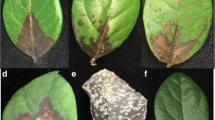Abstract
Forty eight isolates of Phytophthora cinnamomi from various host plants in France (35 isolates) and in other countries were tested for pathogenicity. Seedlings of chestnut, northern red oak, pine and eucalyptus were infected by soil contamination. Taproots, stems and bark strips of plants of chestnut and different oak species were inoculated with mycelium agar disks. Results of the different experiments were in good agreement. All isolates appeared pathogenic to all the different test species but with variable levels of virulence. Isolates with consistent low or high level of virulence, which could be used as standards in further studies, were identified. Interaction between P. cinnamomi isolates and host plant species was significant in terms of lesion lengths. These interactions could not be related to host from which P. cinnamomi was isolated. Consistent with this, in Quercus rubra, the isolate-provenance interaction was not significant. This feature is encouraging for provenance screening for resistance to P. cinnamomi in this species. The variation in virulence was not related to other isolate characteristics (mating type, electrophoretic type, age).
Similar content being viewed by others
References
Brasier CM (1992) Evolutionary biology of Phytophthora. Part 1: genetic system, sexuality and the generation of variation. Annu. Rev. Phytopathol. 30: 135-171
Brasier CM, Robredo and Ferraz JFP (1993) Evidence for Phytophthora cinnamomiinvolvement in Iberian oak decline. Plant pathology 42: 140-145
Brasier C (1996) Phytophthora cinanmomiand oak decline in southern Europe. Environmental constraints including climate change. Ann. Sci. For. 53: 347-358
Byrt P and Grant B (1979) Some conditions governing zoospores production in axenic culture of Phytophthora cinanmomi. Aust. J. Bot. 27: 103-115
Chee KH and Newhook FJ (1965) Variability in Phytophthora cinnamomiRands. N. Z. J. Agric. Res. 8: 947-950
Crandall BS, Gravatt GF and Ryan MM (1945) Root disease of Castaneaspecies and some coniferous and broadleaf nursery stocks, caused by Phytophthora cinnamomi. Phytopathology 35: 162-180
Desprez-Loustau ML and Dupuis F (1994) Spatial distribution and pathogenicity of Phytophthora cinnamomiisolates originating from soil of an infested red oak stand. In: Diseases and insects in forest nurseries: (pp 79-91). Les colloques n∘ 68. (ed) by Perrin and Sutherland, INRA
Dixon KW, Thinlay, Sivasithamparam K (1984). Technique for rapid assessment of tolerance of banksia spp. To root rot caused by Phytophthora cinnamomi. Plant Disease 68(12): 1077-1080
Dudzinski MJ, Old KM and Gibbs RJ (1993) Pathogenic variability in Australian isolates of Phythophthora cinnamomi. Aust. J. Bot. 41(6): 721-732
Linde C, Drenth A, Kemp GHJ, Wingfield MJ and von Broembsen SL (1997) Population structure of Phytophthora cinnamomiin South Africa. Phytopathology 87: 822-827
Manning WJ and Crossan DF (1966 a) Variation in degree of pathogenicity of isolates of Phytophthora cinnamomi to cultivars of Taxus. Plant Disease Reporter 50(2): 84-87
Manning WJ and Crossan DF (1966 b) Evidence for variation in degree of pathogenicity of isolates of Phytophthora cinnamomito broadleaf and coniferous evergreens. Plant Disease Reporter 50(9): 647-649
Marks GC, Smith IW and Kassaby FY (1981). Trunk infection of Eucalypt species by Phytophthora cinnamomi. Aust. J. For. Res. 11: 257-267
Matheron ME and Matejka JC (1989) Temporal changes in susceptibility of citrus phloem tissue to colonization by Phytophthora citrophthoraand P. parasitica. Plant Disease 73: 408-411
Moreau C and Moreau M (1952) Etude mycologique de la maladie de l’encre du chêne. Rev. Pathol. Veg. 31: 201-231
Old KM, Moran GF and Bell JC. (1983) Isozyme variability among isolates of Phytophthora cinnamomifrom Australia and Papua New Guinea. Can. J. Bot. 62: 2016-2022
Old KM, Dudzinski MJ and Bell JC (1988) Isozyme variability in field populations of Phytophthora cinnamomiin Australia. Aust. J. Bot. 36: 355-360
Oudemans P and Coffey MD (1991) Isozyme comparison within and among worldwide sources of three morphologically distinct species of Phytophthora. Mycol. Res. 95(1): 19-30
Podger FD (1989) Comparative pathogenicity of fourteen Australian isolates of Phythophthora cinnamomidetermined on transplants of Tasmanian temperate heathland. Aust. J. Bot. 37: 491-500
Robin C (1991). La maladie de l’encre du chêne rouge Quercus rubraL. causée par Phytophthora cinnamomiRands: perspectives pour l’amélioration génétique de la résistance. Ph. D. Université de Bordeaux II, pp. 140
Robin C (1992) Trunk inoculations of Phytophthora cinnamomiin red oaks.1992. Eur. J. For. Path. 22(2-3): 157-165
Robin C, Desprez-Loustau ML and Delatour C. (1992) Spatial and temporal enlargement of cankers of Phytophthora cinnamomiin red oak. Can. J. For. Res. 22: 3: 362-366
Robin C, Dupuis F, Desprez-Loustau, ML (1994) Seasonal changes in northern red oak susceptibility to Phytophthora cinnamomi. Plant Disease 78: 369-374
SAS Institute Inc. (1989) SAS/STAT User's Guide, Version 6, Fourth Edition, Volume 2, Cary, NC, USA, pp: 891-996
Salesses G and Chapa J (1993) Screening and breeding for ink disease resistance. Proceedings of the International Congress of Chestnut. Spoleto, October 20-23, pp. 545-549
Shaner G, Stromberg EL, Lacy GH, Barker KR, Pirone TP. (1992). Nomenclature and concepts of pathogenicity and virulence. Annu. Rev. Phytopathol. 30: 47-66
Shearer BL and Tippett JT (1989) Jarrah dieback: the dynamics and management of Phytophthora cinnamomiin the Jarrah (Eucalyptus marginata) forest of South-western Australia. CALM, Research Bulletin 3, pp. 75
Torgesson DC (1954) Root rot of Lawson cypress and other ornamentals caused by Phytophthora cinnamomi. Contrib. Boyce Thompson Inst. 17: 359-373
Vegh I and Bourgeois M (1975) Données préliminaires sur l’étiologie du dépérissement des conifères d’ornement dans les pépinières françaises; rôle de Phythophthora cinnamomiRands. Pepinier. Hortic. Maraich 153: 39-49
White RP (1937) Rhododendron wilt and root rot. N. J. Agric. Exp. Stn. Bull. 615 pp. 32
Weste G (1975) Pathogenicity of Phytophthora cinnamomitowards Nothofagus cunninghamii Aust. J. Bot. 23: 277-285
Zentmyer GA (1980) Phytophthora cinnamomiand the diseases it causes. Monograph. n∘ 10. American Phytopathological Society, St Paul, Minnesota, USA
Zentmyer GA and Guillemet FB (1981) Evidence for strains of Phytophthora cinnamomi. Plant disease 65: 475-477
Author information
Authors and Affiliations
Rights and permissions
About this article
Cite this article
Robin, C., Desprez-Loustau, ML. Testing variability in pathogenicity of Phytophthora cinnamomi. European Journal of Plant Pathology 104, 465–475 (1998). https://doi.org/10.1023/A:1008649806620
Issue Date:
DOI: https://doi.org/10.1023/A:1008649806620



